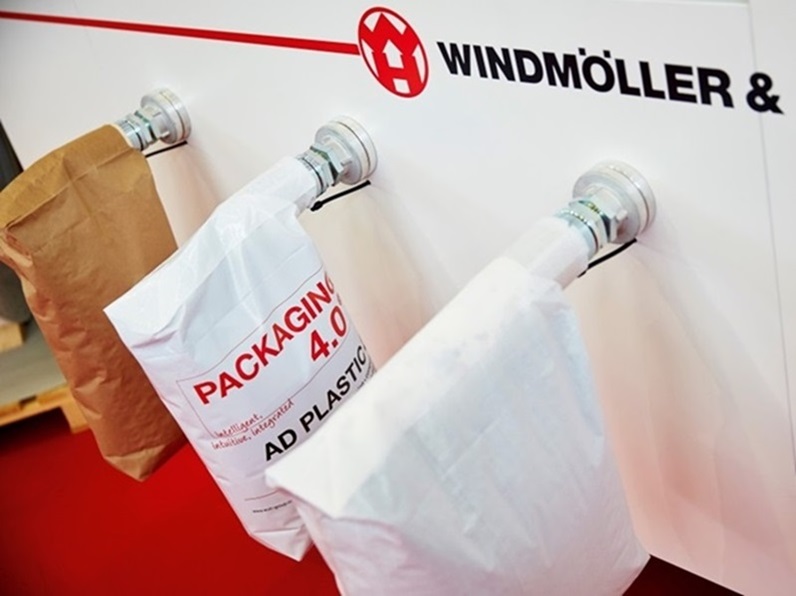
“Why are kraft paper PP bags the gold standard for packaging abrasive and hygroscopic chemicals like cement, gypsum, and industrial powders?”
The answer lies in their hybrid structure: Combining polypropylene (PP) woven layers for tear resistance with kraft paper liners for moisture barrier properties, these bags achieve 30% higher load-bearing capacity and 50% lower leakage rates than conventional options. VidePak, leveraging 30+ years of expertise and Starlinger’s precision engineering, has optimized these bags to meet stringent global standards like ASTM D5265 and AS/NZS 4347, ensuring safe transport and storage for high-risk materials.
1. Structural Integrity: Balancing Strength and Leak Prevention
1.1 Material Selection and Weave Density
Kraft paper PP bags typically employ a 3-layer design:
- Outer PP woven layer (120–150 gsm, 12×12 weave/cm²) for abrasion resistance.
- Middle kraft paper liner (80–120 gsm, FSC-certified) to block moisture ingress.
- Inner PE coating or film (15–50 µm) for dust containment.
VidePak’s Starlinger circular looms ensure ±0.1 mm filament uniformity, critical for minimizing inter-yarn gaps (<0.3 mm) that cause powder leakage. For example, a 2024 trial with a Vietnamese cement producer reduced spillage by 45% using bags with 14×14 weave/cm² density.
1.2 Sealing Technologies
- Heat-sealed valves: Achieve peel strength ≥4 N/cm (ISO 527-3), preventing valve detachment during pneumatic filling.
- Ultrasonic edge sealing: Reduces seam failure rates to <0.5% under 50 kg dynamic loads.
Case Study: A Chilean gypsum supplier reported zero leakage incidents after switching to VidePak’s block-bottom valve bags with double-stitched PE liners.
2. Global Standards and Parameter Optimization
2.1 Compliance with Regional Specifications
| Standard | Key Requirements | VidePak’s Compliance |
|---|---|---|
| EU EN 15512 | Tensile strength ≥35 MPa | 38–42 MPa (PP layer) |
| ASTM D5637 | Moisture barrier ≤2 g/m²/day (50°C, 90% RH) | 1.2–1.8 g/m²/day (kraft + PE) |
| JIS Z 0208 | Stacking height ≥5 m (25 kg bags) | 6 m tested stability |
| AS/NZS 4347 | UV resistance (500 hrs, ≤5% degradation) | 8% degradation after 750 hrs |
Data sourced from VidePak’s 2024 Q4 certification reports.
For Australian mining clients, VidePak uses 200 µm PE coatings to meet AS/NZS 4347’s 10,000+ abrasion cycles requirement.
2.2 Customization for Specific Chemicals
- Cement: 150 gsm PP + 100 gsm kraft + 30 µm PE film (WVTR ≤1.5 g/m²/day).
- Plaster powder: Anti-static PP weaves (surface resistivity ≤10⁹ Ω/sq) to prevent dust explosions.
- Aggregates (e.g., gravel): 180 gsm PP with 18×18 weave/cm² for puncture resistance.
3. VidePak’s Manufacturing Excellence
With 100+ Starlinger looms and 30 lamination machines, VidePak achieves:
- Precision extrusion: PP filaments (2.5–3.0 mm width) with tensile strength ≥38 MPa.
- Multi-layer lamination: PE/kraft adhesion strength ≥3.5 N/cm (ISO 8510-2).
- Capacity: 12 million bags/month, supporting 3-day rush orders for emergency shipments.
Production Parameters:
| Process | Specification | Quality Impact |
|---|---|---|
| Extrusion temperature | 220°C ±2°C | Prevents PP crystallinity defects |
| Weave tension | 25–30 N/cm² | Ensures uniform pore distribution |
| Lamination speed | 150 m/min | Maintains 0.1 mm coating thickness |
4. FAQs
Q: How do I choose between coated and uncoated kraft liners?
A: Use PE-coated liners for humidity >60% (e.g., Southeast Asia) and uncoated for dry climates (e.g., Middle East) to balance cost and performance.
Q: What stack height is safe for 25 kg chemical bags?
A: VidePak’s 6-ply block-bottom designs support 8 m stacking (vs. industry average 5 m) without bulging.
5. Conclusion
Kraft paper PP bags represent the convergence of material science and regulatory compliance. VidePak’s integration of Starlinger technology, FSC-certified materials, and data-driven customization positions it as a leader in chemical packaging. As sustainability mandates tighten—particularly under EU Circular Economy directives—innovations like biodegradable PE coatings will further redefine this sector.
For insights into high-barrier chemical packaging, explore our analysis of moisture-proof woven bag solutions, or learn how recyclable PP bags align with ESG goals.
References
- ASTM International. (2024). Standard Test Methods for Tensile Properties of Plastics.
- European Committee for Standardization. (2023). EN 15512: Steel static storage systems.
- International Organization for Standardization. (2024). ISO 527-3: Plastics—Determination of tensile properties.
- JIS Handbook. (2024). Japanese Industrial Standards for Packaging.
- VidePak Internal Quality Reports. (2024). Certification Compliance Data.